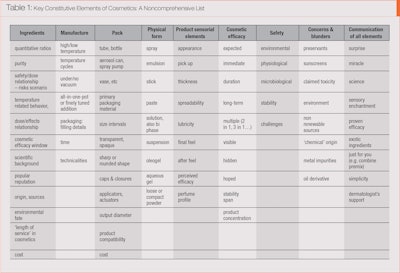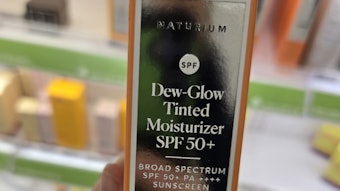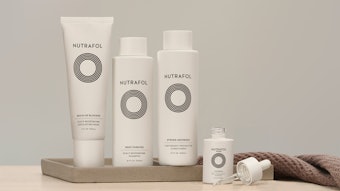Today’s cosmetics industry is under enormous pressure to create innovative new products that help consumers feel beautiful and refreshed. And that’s just where the push for innovation starts. Other key drivers pushing the innovation envelope for cosmetic scientists include:
- environmental impact
- the quest of higher safety levels for the skin and body
- scientifically proven performances
And of course, all of it needing to be achieved at an affordable price.
Scientific development always offers new ingredients to the formulation scientist, together with old-fashioned ‘naturals’ revamped as ‘organic’ or, as referred to in Europe, ‘biological’.
An additional challenge for new products to meet today is their sustainability, which is no longer separate from the basic raw materials research. Simplified production runs, ecological certifications, biodegradable chemical structures and the absence of solvents and impurities are all among the characteristics of green chemistry, besides the urgent quest for the important reduction of emissions and energy consumption.
The new safety aspects required by consumers go well beyond the lack of eye or mucosa irritation. The actual picture is the maximization of skin compatibility that comes from considering the skin as an environment, which needs protection and redress. The new frontier of cosmetics is the complete tolerability of products by atopics, babies and senior citizens—in other words, by people with sensitive skin, impaired skin conditions or skin hyper-reactivity.
Besides common terms used on labels such as ‘non sensitizer’ or ‘non comedogenic,’ strict control of all impurities (like metals and allergens) is now required. The clear identification of the active principles in traditionally used vegetal extracts offers new scientific support to ethnic cosmetology. Instead of simple molecules, the industry now offers organized cosmetic systems as active principles. They practice a mimesis of the cutaneous structures inspired by skin biochemistry and suggest skin lipids supplements instead of their elimination in cleansing procedures. Multiple actions, epidermal repair and supplemented delivery offer new opportunities for the development of efficient skin cosmetics.
Innovation
The path to innovation remains harsh. Search for new and creative products strategically, remaining vigilant to discard the hundreds of alternative solutions that continuously pop-up during research. At the same time, pay adequate attention to ‘odd’ ideas that suddenly appear serendipitously and could potentially be a source of effective discoveries. The cosmetic world is continuously changing; creativity and real innovation remain the key factors to success. How does one search adequately in the blue sky of ‘non-existing products’?
A Strategy for Innovation?
In the field of systemic constellations1, a strategy to solve inter-personal conflicts when A or B are considered possible solutions to a problem, one should also look to other alternatives. For instance, consider combining A and B, or look for other solutions that do not include or consider A or B at all.
A fifth element should also be considered, which like a satellite lies in the ideal space around the problem. Creativity takes into account all non-rational elements, hidden aspects, mood details, recent trends and nebulous discoveries. How to optimize such an element in order to help our innovation task requires a look at a possible operating system for the sorcerer’s apprentice cosmetologist. Begin by describing the constitutive elements of a cosmetic product; it is best to make a list them (see Table 1).
Next, for each of these elements, think about what could be done differently to produce a new and exciting result. Innovative formulators should rely on their creativity to discover ‘new,’ ‘extraordinary,’ ‘never-before-seen’ and ‘long-desired’ characteristics that could be invented or sharply modified. This reasoning can be applied to as few or as many of these elements as each individual application demands, with the result of this ‘creative thinking’ being the first step in inventing new products.
Other questions to consider: Which radical improvements could be carried out? Which are the imperfect elements, related to this specific descriptor, in existing products? If a breakthrough were to happen, which desirable changes would occur stylebook1? How will the consumer perceive them?
Given the formulator’s ability to conceptualize, next to determine are the scientific steps to bring that abstract idea to reality.
Creativity Commences
Meanwhile, we should make ready our working tools. One cannot be innovative if not well acquainted with all main elements of the action field where innovation is required. One’s personal warehouse of knowledge (see Table 1) should be top of mind, with all its references and highlights.
Knowledge renovation should be continuous. Staying up to date about new developments in the specific section of our interest is a must. Magazines, journals, the Internet, monographies, raw materials suppliers, exhibitions and congresses are all precious sources of ideas. Participate in meetings where ideas are discussed, implemented and challenged, and careful examination of new products launches may help identify the most recent answers to consumers’ needs.
Update in ‘alternative’ fields: A glance to other industrial and scientific sectors that have a close connection to cosmetics, like dermatology, food sciences, biochemistry and social sciences is also necessary. Cosmetics follow the (fast) development of our society: any changing element may suggest a trend; a new need; a hint for drafting ideas.
For example: could the structure of a water-resistant sunscreen be suitable for an intimate hygiene cleanser? As the new borders of cleansing products require skin restitution properties, enhanced barrier effects and the respect and implementation of resident flora, the lasting properties of a sunscreen could well be adapted to these needs.
Practical Trials
Don’t be afraid to experiment with ideas that appear, at first glance, absurd. Don’t back down from skeptical colleagues. It is certainly easier to follow the standard rules; behaving as all the others do rarely produces mistakes. However, being creative also means that eight or nine times out of 10 often results in failure. But this is the price of creativity.
Project Drafting
Contrary to what happens in other fields, the definition of the project in the cosmetic field often coincides with the performing of explorative practical trials. Experimental outcomes, in order to seek innovation, should be free and without predetermined conceptual schemes.
As a preliminary step, it is necessary to verify the rough practicality of a new idea. Defining too precisely in advance a series of small details or side aspects could kill creativity in its cradle. Multiple interactions of ingredients in cosmetic recipes can create wicked problems, where any new addition influences all the other variables of the system, often in an unpredictable way.
Let yourself become astonished by the outcome of a new blend! Even the simple but controlled introduction of air bubbles in a formula can sharply modify sensory perceptions, application and performances.
Ingredients
The creative/innovative use of ingredients (as Chris Dederen says2: ingredients in cosmetics are used like words in a poetry) might certainly be grounded on ideas derived from knowledge and experience but could also be the fruit of casual combinations deriving from practical trials and systematic studies.
For instance, the common stearic acid might be used as bodying agent in O/W emulsions, as a source of emulsifier alkali stearate, a ‘temporary’ emulsifiers that reverse to the free acid in contact with the skin. But it also could become the key ingredient in soaps and shaving products, a pearling agent in cleansing product, as provider of final dry skin feel in the same category of products, as coating to pigments and mineral sunscreens, just to mention the most known applications. This without exploring its variable behavior at different neutralization degrees and with different alkaline molecules!
A good exercise for the beginner could be to compare these applications with those of its parent molecule, isostearic acid, similar but different for many aspects. Indeed, to build up a formula around the features of one ingredient provides a good set of possibilities of new puzzling developments.3
Technicalities
In makeup products, creativity has led to the development of liquid makeup to be applied with a sponge, or to multiple color compact powders. Also to lipsticks that do not require the flaming operation because their molds are made of retractable silicone. Innovation on the applicator form, shape and material has developed hundreds of different types in the last decades (and of the coupled wipers).
The dermatologists requirements for products containing only minimal traces of nickel has brought to enhanced purity profile of many cosmetic ingredients, while the purity required to lubricants used for space crafts has led to the application in cosmetics of food grade hydrogenated polydecenes. The quest for ‘alternative’ preservants is shaking the world of ingredients research, which is looking for contemporary efficacy and safety for human cells for raw material intended to act as efficient killers for bacteria and fungi.
Conclusion
It should be remembered that the most fragile innovation is made of easy foreseeable elements4. Therefore, dare to be creative! Negativity, sense of discomfort or surrender cannot help in this task. Unforeseeable barriers are the sparks that can illuminate your creativity efforts.
References
- Katja Petrovic (2012) Systemic Constellations: A New Approach to Psychotherapy. Master of Psychology course, Monash University, Melbourne, Australia
- Chris Dederen: personal communication
- 36 Surprising Ways to Boost Creativity for Free http://greatist.com/happiness/ways-to-boost-creativity (consulted Jan. 2016)
- Taleb NN (2012) Antifragile ISBN 9788842819172, Il Saggiatore, Milano











